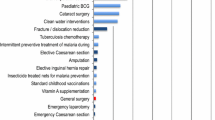Abstract
Background
A cost-effective analysis (CEA) can be a useful tool to guide resource allocation decisions. However, there is a dearth of evidence on the cost/disability-adjusted life year (DALY) averted by health facilities in the developing world.
Methods
We conducted a study to calculate the costs and the DALYs averted by an entire hospital in Sierra Leone, using the method suggested by McCord and Chowdhury (Int J Gynaecol Obstet 2003;81:83–92).
Results
For the 3-month study period, total costs were calculated to be $369,774. Using the approach of McCord and Chowdhury, we calculated that 11,282 DALYs were averted during the study period, resulting in a cost/DALY averted of $32.78. This figure compares favorably to other non-surgical health interventions in developing countries. We found that while surgery accounts for 63% of total caseload, it contributes to 38% of the total DALYs averted.
Conclusions
Surgical treatment of some common pathologies in developing countries may be more cost-effective than previously thought, and our results provide evidence for the inclusion of surgery as part of the basic public health armamentarium in developing countries. However, these results are highly context-specific, and more research is needed from developing countries to further refine the methodology and analysis.

Similar content being viewed by others
References
Adam T, Baltussen R, Tan Torres T, et al. Making Choices in Health: WHO Guide to Cost Effectiveness Analysis. Geneva, World Health Organization, 2003
Baltussen R, Sylla M, Mariotti SP. Cost-effectiveness analysis of cataract surgery: a global and regional analysis. Bull WHO 2004;82:338–345
Marseille E. Cost-effectiveness of cataract surgery in a public health eye care programme in Nepal. Bull WHO 1996;74:319–324
Singh AJ, Garner P, Floyd K. Cost-effectiveness of public-funded options for cataract surgery in Mysore, India. Lancet 2000;355:180–184
Jamison D, Evans D, Alleyne G, et al., editors. Disease Control Priorities in Developing Countries. 2nd ed. Washington, DC, World Bank, Forthcoming 2006
McCord C, Chowdhury Q. A cost effective small hospital in Bangladesh: what it can mean for emergency obstetric care. Int J Gynaecol Obstet 2003;81:83–92
Jamison DT, International Bank for Reconstruction and Development. Disease Control Priorities in Developing Countries. New York, Oxford University Press for the World Bank, 1993
Mills AJ, Kapalamula J, Chisimbi S. The cost of the district hospital: a case study in Malawi. Bull WHO 1993;71:329–339
Lewis MA, La Forgia GM, Sulvetta MB. Measuring public hospital costs: empirical evidence from the Dominican Republic. Soc Sci Med 1996;43:221–234
Malalasekera AP, Ariyaratne MH, Fernando R, et al. Cost accounting in a surgical unit in a teaching hospital—a pilot study. Ceylon Med J 2003;48:71–74
Shepard D, Walsh J, Munar W, et al. Cost-effectiveness of ambulatory surgery in Cali, Colombia. Health Policy Plan 1993;8:136–142
Jha P, Bangoura O, Ranson K. The cost-effectiveness of forty health interventions in Guinea. Health Policy Plan 1998;13:249–262
Murray CJ. Quantifying the burden of disease: the technical basis for disability-adjusted life years. Bull WHO 1994;72:429–445
Murray CJL, Lopez AD, Harvard School of Public Health, World Health Organization., World Bank. The global burden of disease: a comprehensive assessment of mortality and disability from diseases, injuries, and risk factors in 1990 and projected to 2020. Cambridge, MA: Harvard School of Public Health for the World Health Organization and the World Bank; Distributed by Harvard University Press, 1996
Arnesen T, Nord E. The value of DALY life: problems with ethics and validity of disability adjusted life years. BMJ 1999;319:1423–1425
Bastian H. A consumer trip into the world of the DALY calculations: an Alice-in-Wonderland experience. Reprod Health Matters 2000;8:113–116
Reidpath DD, Allotey PA, Kouame A, et al. Measuring health in a vacuum: examining the disability weight of the DALY. Health Policy Plan 2003;18:351–356
Author information
Authors and Affiliations
Corresponding author
APPENDIX 1: EXAMPLE OF DALY ESTIMATION
APPENDIX 1: EXAMPLE OF DALY ESTIMATION
-
A 15-year-old male with peritonitis who undergoes successful surgery (>95% mortality without treatment, >95% chance of permanent cure) 36.80 (YLL value for males aged 15) × 1.0 × 1.0 = 36.80 DALYs averted by surgery.
-
A 5-year-old female successfully treated for very severe anemia/malaria (>95% mortality without treatment, <50% chance of permanent cure of the condition)
-
36.59 (YLL value for females aged 5) × 1.0 × 0.3 = 11 DALYs averted by treatment.
-
A 20-year-old male who survives a road traffic accident with a unilateral below-knee amputation (<95% mortality without treatment, >95% chance of permanent disability, with weight of 0.281) 35.02 × 0.7 × 1.0 × 0.281 = 6.9 DALYs averted by surgery.
The above calculations were undertaken to estimate the DALYs averted for all patients seen during the 3-month period. Calculations were done individually for all inpatients. Because patients keep their own outpatient charts, the available data from OPD are less explicit, but age, sex, diagnosis, and treatment were retrievable from the OPD log books. Manual reduction of sedated patients with incarcerated inguinal hernias, for example, was successful 39 times. These patients had a mean age of 37 years, and we estimate that >50% would eventually have died without any treatment and that the treatment is successful (i.e., definitive) in <50% of the cases. DALYs were calculated as follows: 39 × 26 (YLL value for males aged 37) × 0.7 × 0.3 = 213 DALYs averted. The same principles were applied for fractures treated in OPD: 338 patients, of mean age 24 years, with the assumption that 10% of these would have a greater than 50% chance of some form of permanent disability. This averted 785 DALYs, which for 338 patients of mean age 24 is probably an overly conservative estimate.
Rights and permissions
About this article
Cite this article
Gosselin, R.A., Thind, A. & Bellardinelli, A. Cost/DALY Averted in a Small Hospital in Sierra Leone: What Is the Relative Contribution of Different Services?. World J. Surg. 30, 505–511 (2006). https://doi.org/10.1007/s00268-005-0609-5
Published:
Issue Date:
DOI: https://doi.org/10.1007/s00268-005-0609-5



